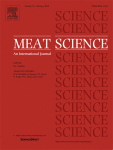Ver ítem
- xmlui.general.dspace_homeCentros e Institutos de InvestigaciónCIA. Centro de Investigaciones de AgroindustriaInstituto de Tecnología de AlimentosArtículos científicosxmlui.ArtifactBrowser.ItemViewer.trail
- Inicio
- Centros e Institutos de Investigación
- CIA. Centro de Investigaciones de Agroindustria
- Instituto de Tecnología de Alimentos
- Artículos científicos
- Ver ítem
Inactivation of Shiga toxin-producing Escherichia coli in fresh beef by electrolytically-generated hypochlorous acid, peroxyacetic acid, lactic acid and caprylic acid
Resumen
Several studies have been conducted to verify the decontamination potential of electrolyticallygenerated hypochlorous acid, peroxyacetic acid, lactic acid and caprylic acid against Shiga toxin-producing Escherichia coli (STEC) in beef products. However, there is no consensus
regarding their effectiveness. The aim of this study was to compare these four treatments under the same conditions and establish a ranking according to their effectiveness to
[ver mas...]
Several studies have been conducted to verify the decontamination potential of electrolyticallygenerated hypochlorous acid, peroxyacetic acid, lactic acid and caprylic acid against Shiga toxin-producing Escherichia coli (STEC) in beef products. However, there is no consensus
regarding their effectiveness. The aim of this study was to compare these four treatments under the same conditions and establish a ranking according to their effectiveness to inactivate STEC in fresh beef. Samples were inoculated with two levels of inoculum and rinsed for 15 s in 100 ml of antimicrobial solution treatment. Caprylic acid was the most effective treatment, followed by lactic acid and peroxyacetic acid. Electrolytically-generated hypochlorous acid had no effect. Sensory analysis showed no significant differences either in flavor or in color between
samples treated with caprylic acid and reference samples. Caprylic acid appears to be an effective and viable alternative to conventional interventions frequently used for meat product decontamination.
[Cerrar]

Autor
Cap, Mariana;
Vaudagna, Sergio Ramon;
Mozgovoj, Marina Valeria;
Soteras, Trinidad;
Sucari, Adriana;
Signorini, Marcelo;
Leotta, Gerardo;
Fuente
Meat Science 157 : 107886 (2019)
Fecha
2019-07-05
Editorial
Elsevier
ISSN
0309-1740
1873-4138
1873-4138
Formato
pdf
Tipo de documento
artículo
Palabras Claves
Derechos de acceso
Restringido
 Excepto donde se diga explicitamente, este item se publica bajo la siguiente descripción: Creative Commons Attribution-NonCommercial-ShareAlike 2.5 Unported (CC BY-NC-SA 2.5)
Excepto donde se diga explicitamente, este item se publica bajo la siguiente descripción: Creative Commons Attribution-NonCommercial-ShareAlike 2.5 Unported (CC BY-NC-SA 2.5)

